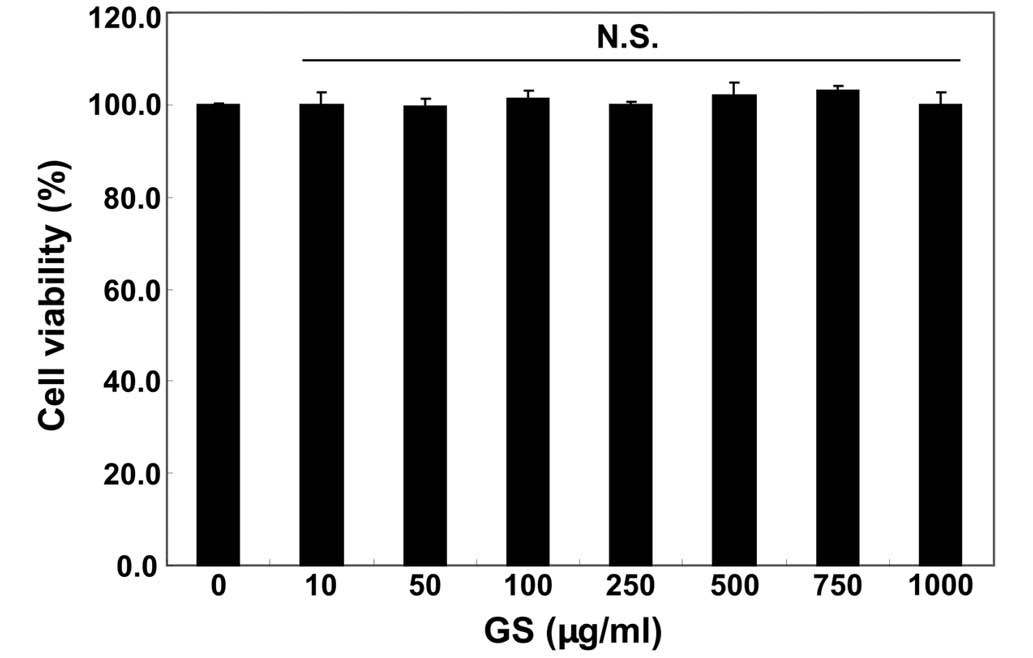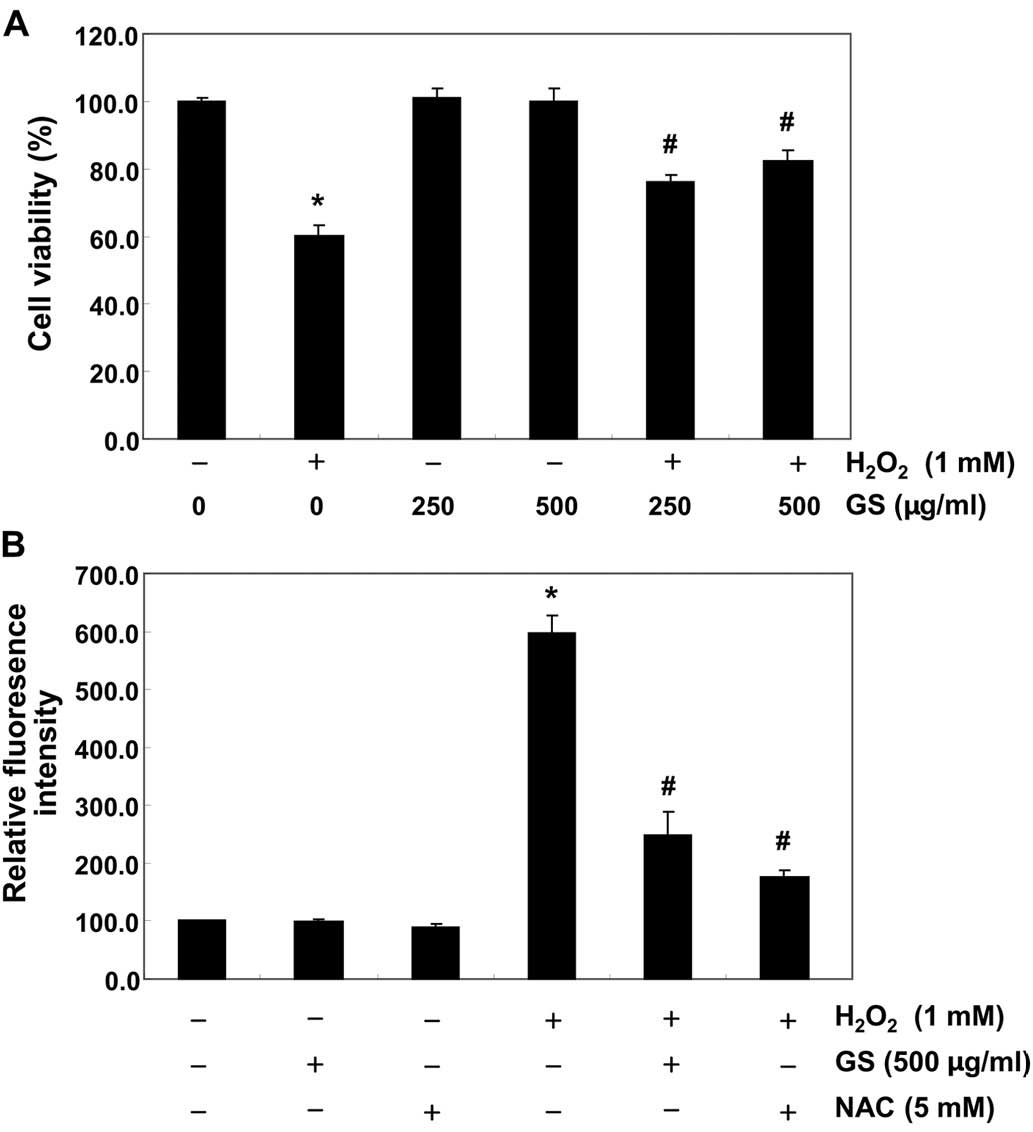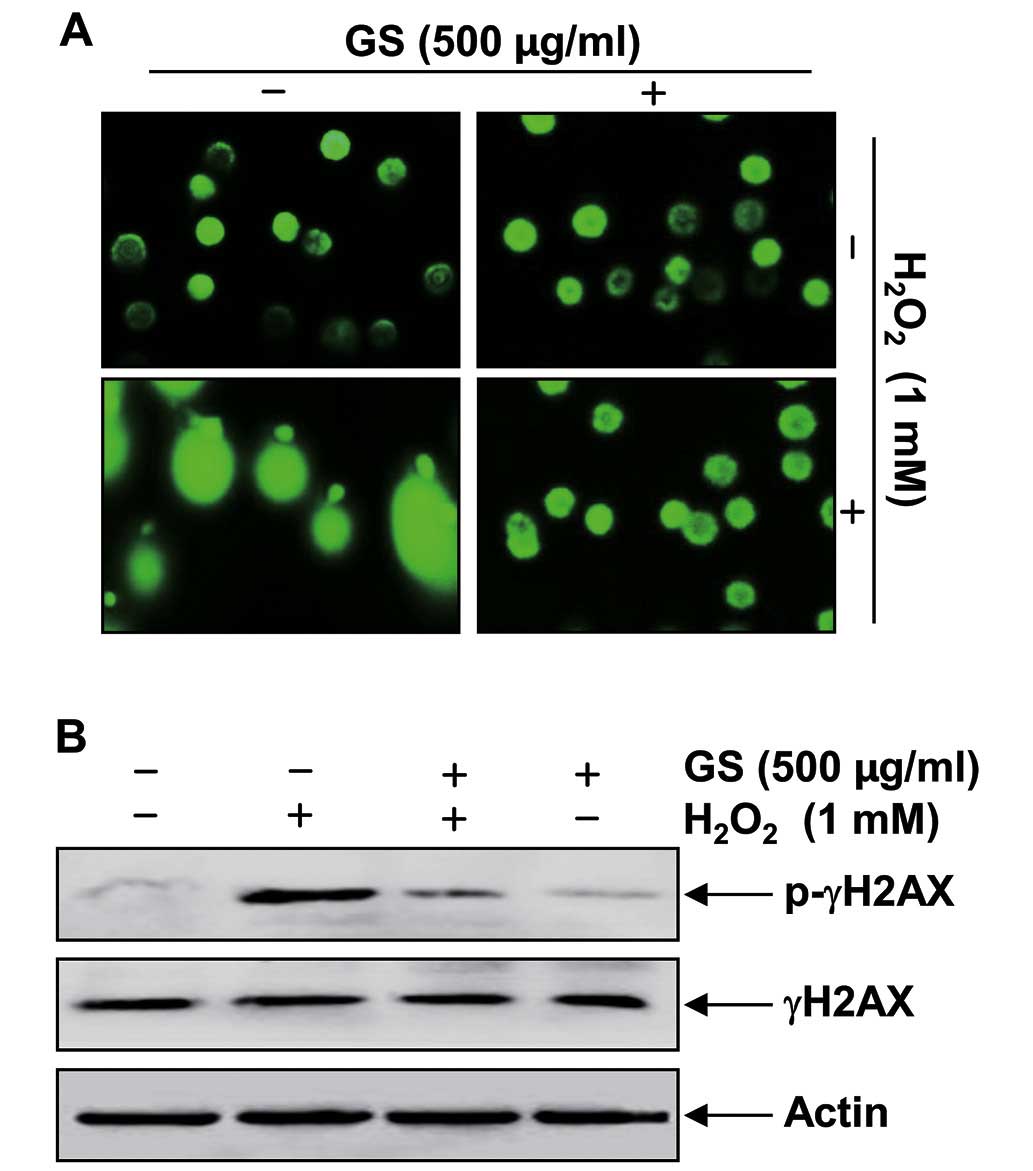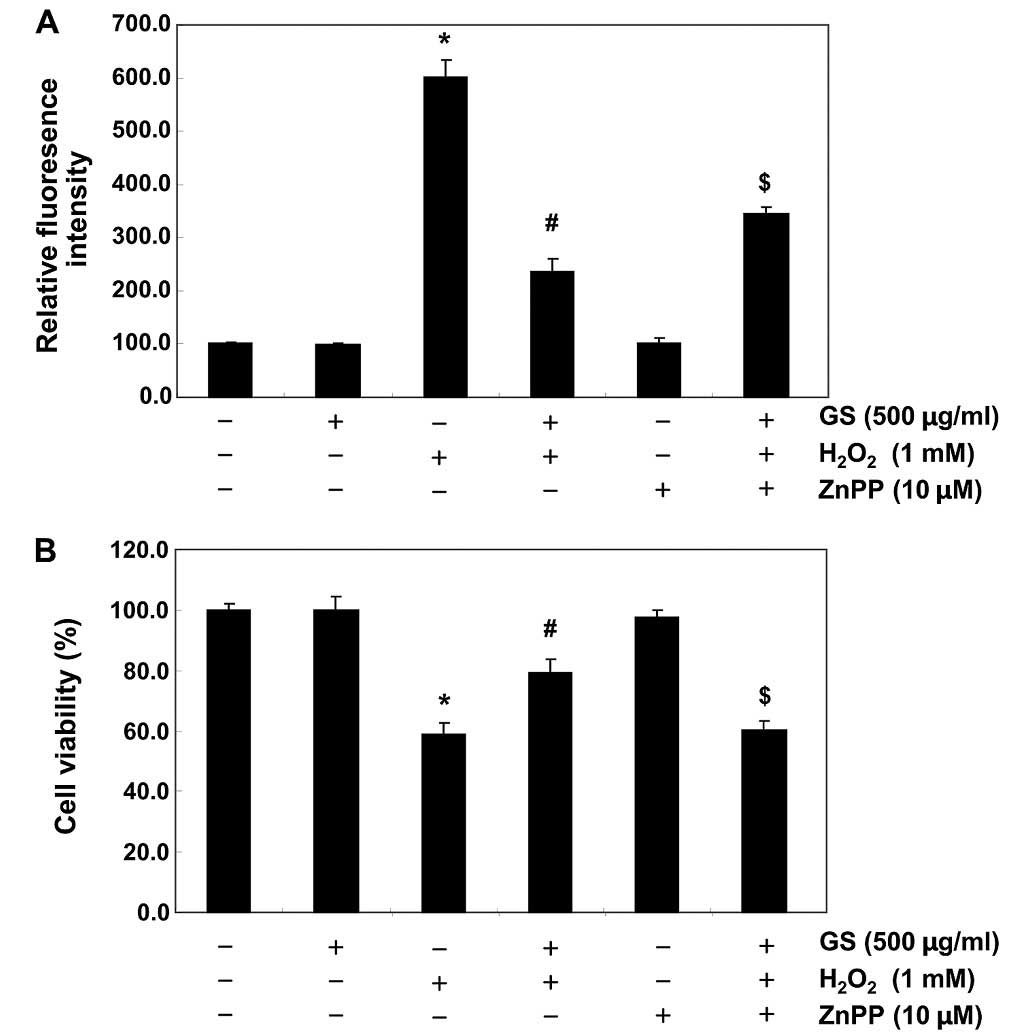|
1
|
Kregel KC and Zhang HJ: An integrated view
of oxidative stress in aging: basic mechanisms, functional effects,
and pathological considerations. Am J Physiol Regul Integr Comp
Physiol. 292:R18–R36. 2007. View Article : Google Scholar
|
|
2
|
Finkel T: Signal transduction by reactive
oxygen species. J Cell Biol. 194:7–15. 2011. View Article : Google Scholar : PubMed/NCBI
|
|
3
|
Venugopal R and Jaiswal AK: Nrf1 and Nrf2
positively and c-Fos and Fra1 negatively regulate the human
antioxidant response element-mediated expression of NAD(P)H:quinone
oxido-reductase1 gene. Proc Natl Acad Sci USA. 93:14960–14965.
1996. View Article : Google Scholar
|
|
4
|
Zhang Y and Gordon GB: A strategy for
cancer prevention: stimulation of the Nrf2-ARE signaling pathway.
Mol Cancer Ther. 3:885–893. 2004.PubMed/NCBI
|
|
5
|
Kaspar JW, Niture SK and Jaiswal AK:
Nrf2:INrf2 (Keap1) signaling in oxidative stress. Free Radic Biol
Med. 47:1304–1309. 2009. View Article : Google Scholar : PubMed/NCBI
|
|
6
|
Niture SK, Khatri R and Jaiswal AK:
Regulation of Nrf2-an update. Free Radic Biol Med. 66:36–44. 2014.
View Article : Google Scholar
|
|
7
|
Surh YJ, Kundu JK and Na HK: Nrf2 as a
master redox switch in turning on the cellular signaling involved
in the induction of cytoprotective genes by some chemopreventive
phytochemicals. Planta Med. 74:1526–1539. 2008. View Article : Google Scholar : PubMed/NCBI
|
|
8
|
Qaisiya M, Coda Zabetta CD, Bellarosa C
and Tiribelli C: Bilirubin mediated oxidative stress involves
antioxidant response activation via Nrf2 pathway. Cell Signal.
26:512–520. 2014. View Article : Google Scholar
|
|
9
|
Nguyen CN, Kim HE and Lee SG:
Caffeoylserotonin protects human keratinocyte HaCaT cells against
H2O2-induced oxidative stress and apoptosis
through upregulation of HO-1 expression via activation of the
PI3K/Akt/Nrf2 pathway. Phytother Res. 27:1810–1818. 2013.
View Article : Google Scholar : PubMed/NCBI
|
|
10
|
Bates DJ, Smitherman PK, Townsend AJ, King
SB and Morrow CS: Nitroalkene fatty acids mediate activation of
Nrf2/ARE-dependent and PPARγ-dependent transcription by distinct
signaling pathways and with significantly different potencies.
Biochemistry. 50:7765–7773. 2011. View Article : Google Scholar : PubMed/NCBI
|
|
11
|
Landete JM: Dietary intake of natural
antioxidants: vitamins and polyphenols. Crit Rev Food Sci Nutr.
53:706–721. 2013. View Article : Google Scholar : PubMed/NCBI
|
|
12
|
Kwak JS, Kim JY, Paek JE, Lee YJ, Kim HR,
Park DS and Kwon O: Garlic powder intake and cardiovascular risk
factors: a meta-analysis of randomized controlled clinical trials.
Nutr Res Pract. 8:644–654. 2014. View Article : Google Scholar : PubMed/NCBI
|
|
13
|
Rana SV, Pal R, Vaiphei K, Sharma SK and
Ola RP: Garlic in health and disease. Nutr Res Rev. 24:60–71. 2011.
View Article : Google Scholar : PubMed/NCBI
|
|
14
|
Capasso A: Antioxidant action and
therapeutic efficacy of Allium sativum L. Molecules. 18:690–700.
2013. View Article : Google Scholar : PubMed/NCBI
|
|
15
|
Nencini C, Menchiari A, Franchi GG and
Micheli L: In vitro antioxidant activity of aged extracts of some
Italian Allium species. Plant Foods Hum Nutr. 66:11–16. 2011.
View Article : Google Scholar : PubMed/NCBI
|
|
16
|
Lanzotti V, Barile E, Antignani V,
Bonanomi G and Scala F: Antifungal saponins from bulbs of garlic,
Allium sativum L. var. Voghiera. Phytochemistry. 78:126–134. 2012.
View Article : Google Scholar : PubMed/NCBI
|
|
17
|
Khalil WK, Ahmed KA, Park MH, Kim YT, Park
HH and Abdel-Wahhab MA: The inhibitory effects of garlic and Panax
ginseng extract standardized with ginsenoside Rg3 on the
genotoxicity, biochemical, and histological changes induced by
ethylenediaminetetraacetic acid in male rats. Arch Toxicol.
82:183–195. 2008. View Article : Google Scholar
|
|
18
|
Amagase H: Clarifying the real bioactive
constituents of garlic. J Nutr. 136(Suppl 3): 716S–725S.
2006.PubMed/NCBI
|
|
19
|
Matsuura H: Saponins in garlic as
modifiers of the risk of cardiovascular disease. J Nutr. 131(3s):
1000S–1005S. 2001.PubMed/NCBI
|
|
20
|
Lacaille-Dubois MA and Wagner H: A review
of the biological and pharmacological activities of saponins.
Phytomedicine. 2:363–386. 1996. View Article : Google Scholar : PubMed/NCBI
|
|
21
|
Fehresti Sani M, Montasser Kouhsari S and
Moradabadi L: Effects of three medicinal plants extracts in
experimental diabetes: antioxidant enzymes activities and plasma
lipids profiles in comparison with metformin. Iran J Pharm Res.
11:897–903. 2012.PubMed/NCBI
|
|
22
|
Luo H, Huang J, Liao WG, Huang QY and Gao
YQ: The antioxidant effects of garlic saponins protect PC12 cells
from hypoxia-induced damage. Br J Nutr. 105:1164–1172. 2011.
View Article : Google Scholar : PubMed/NCBI
|
|
23
|
Song JL, Choi JH, Seo JH, Kil JH and Park
KY: Antioxidative effects of fermented sesame sauce against
hydrogen peroxide-induced oxidative damage in LLC-PK1 porcine renal
tubule cells. Nutr Res Pract. 8:138–145. 2014. View Article : Google Scholar : PubMed/NCBI
|
|
24
|
Kang JS, Han MH, Kim GY, Kim CM, Kim BW,
Hwang HJ and Hyun Y: Nrf2-mediated HO-1 induction contributes to
antioxidant capacity of a Schisandrae Fructus ethanol extract in
C2C12 myoblasts. Nutrients. 6:5667–5678. 2014. View Article : Google Scholar : PubMed/NCBI
|
|
25
|
Rogakou EP, Pilch DR, Orr AH, Ivanova VS
and Bonner WM: DNA double-stranded breaks induce histone H2AX
phosphorylation on serine 139. J Biol Chem. 273:5858–5868. 1998.
View Article : Google Scholar : PubMed/NCBI
|
|
26
|
Kim SJ, Ho Hur J, Park C, Kim HJ, Oh GS,
Lee JN, Yoo SJ, Choe SK, So HS, Lim DJ, Moon SK and Park R:
Bucillamine prevents cisplatin-induced ototoxicity through
induction of glutathione and antioxidant genes. Exp Mol Med.
47:e1422015. View Article : Google Scholar : PubMed/NCBI
|
|
27
|
Pischke SE, Zhou Z, Song R, Ning W, Alam
J, Ryter SW and Choi AM: Phosphatidylinositol 3-kinase/Akt pathway
mediates heme oxygenase-1 regulation by lipopolysaccharide. Cell
Mol Biol (Noisy-le-grand). 51:461–470. 2005.
|
|
28
|
Paine A, Eiz-Vesper B, Blasczyk R and
Immenschuh S: Signaling to heme oxygenase-1 and its
anti-inflammatory therapeutic potential. Biochem Pharmacol.
80:1895–1903. 2010. View Article : Google Scholar : PubMed/NCBI
|
|
29
|
Yang JJ, Tao H, Huang C and Li J: Nuclear
erythroid 2-related factor 2: a novel potential therapeutic target
for liver fibrosis. Food Chem Toxicol. 59:421–427. 2013. View Article : Google Scholar : PubMed/NCBI
|
|
30
|
Abruzzo PM, Esposito F, Marchionni C, di
Tullio S, Belia S, Fulle S, Veicsteinas A and Marini M: Moderate
exercise training induces ROS-related adaptations to skeletal
muscles. Int J Sports Med. 34:676–687. 2013. View Article : Google Scholar : PubMed/NCBI
|
|
31
|
Kumar S, Kain V and Sitasawad SL: High
glucose-induced Ca2+ overload and oxidative stress
contribute to apoptosis of cardiac cells through mitochondrial
dependent and independent pathways. Biochim Biophys Acta.
1820:907–920. 2012. View Article : Google Scholar : PubMed/NCBI
|
|
32
|
Li NS, Luo XJ, Zhang YS, He L, Liu YZ and
Peng J: Phloroglucinol protects gastric mucosa against
ethanol-induced injury through regulating myeloperoxidase and
catalase activities. Fundam Clin Pharmacol. 25:462–468. 2011.
View Article : Google Scholar
|
|
33
|
Klimathianaki M, Vaporidi K and
Georgopoulos D: Respiratory muscle dysfunction in COPD: from
muscles to cell. Curr Drug Targets. 12:478–488. 2011. View Article : Google Scholar : PubMed/NCBI
|
|
34
|
Yao Y, Xiao Z, Wong S, Hsu YC, Cheng T,
Chang CC, Bian L and Mak AF: The effects of oxidative stress on the
compressive damage thresholds of C2C12 mouse myoblasts:
implications for deep tissue injury. Ann Biomed Eng. 43:287–296.
2015. View Article : Google Scholar : PubMed/NCBI
|
|
35
|
Kim EK and Choi EJ: Pathological roles of
MAPK signaling pathways in human diseases. Biochim Biophys Acta.
1802:396–405. 2010. View Article : Google Scholar : PubMed/NCBI
|
|
36
|
Winter-Vann AM and Johnson GL: Integrated
activation of MAP3Ks balances cell fate in response to stress. J
Cell Biochem. 102:848–858. 2007. View Article : Google Scholar : PubMed/NCBI
|
|
37
|
Park JY, Kang KA, Kim KC, Cha JW, Kim EH
and Hyun JW: Morin induces heme oxygenase-1 via ERK-Nrf2 signaling
pathway. J Cancer Prev. 18:249–256. 2013. View Article : Google Scholar
|
|
38
|
Jiang G, Hu Y, Liu L, Cai J, Peng C and Li
Q: Gastrodin protects against MPP(+)-induced oxidative stress by up
regulates heme oxygenase-1 expression through p38 MAPK/Nrf2 pathway
in human dopaminergic cells. Neurochem Int. 75:79–88. 2014.
View Article : Google Scholar : PubMed/NCBI
|
|
39
|
Jun YJ, Lee M, Shin T, Yoon N, Kim JH and
Kim HR: eckol enhances heme oxygenase-1 expression through
activation of Nrf2/JNK pathway in HepG2 cells. Molecules.
19:15638–15652. 2014. View Article : Google Scholar : PubMed/NCBI
|


















